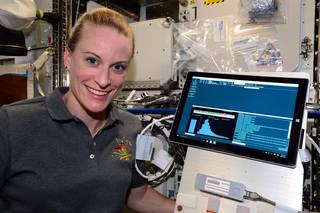
DNA was successfully sequenced in space for the first time ever
For the first time ever, a NASA astronaut has successfully sequenced DNA in microgravity. The feat was conducted as part of the Biomolecule Sequencer experiment aboard the International Space Station and opens the doors to a plethora of scientific and medical possibilities.
If you remember from biology class, DNA contains the instructions that each cell in an organism needs to live. The number and arrangement of the four chemical bases of DNA (adenine, guanine, cytosine, and thyminebases) differ among organisms and their sequence can be used to identify a specific organism.

Now that there’s a way to sequence DNA in space allowing astronauts to diagnose an illness or identify microbes that are growing in the International Space Station to determine whether or not they pose a threat. A space-based DNA sequencer would be able to protect astronaut health on long missions, such as the planned Mars mission, and in the future could even be used to identify DNA-based life forms beyond Earth.
Researchers weren’t sure how the DNA sequencer would operate in a microgravity environment, though. According to Aaron Burton, NASA planetary scientist and principal investigator, the formation of air bubbles in the fluid could pose a challenge. When used on Earth, the bubbles rise to the top of a liquid solution and can be removed by centrifuge, but in space, bubbles are less predictable.
“In space, if an air bubble is introduced, we don’t know how it will behave,” said Burton. “Our biggest concern is that it could block the nanopores.”
The demonstration also proved that the device could withstand the vibrations that occur during launch.
“Those are just the potential problems we’ve identified,” said Sarah Castro-Wallace, project manager and NASA microbiologist. “A lot of the things that might introduce errors are simply unknown at this point.”
To prep for the experiments, researchers tested the entire sequencing process on a NASA Extreme Environment Mission Operation, NEEMO, in the Aquarius Base research facility 60 feet underwater off the coast of Florida.
“The NEEMO tests went smoothly,” said Castro-Wallace. “In terms of a harsh environment, with different humidity, temperature and pressure, we looked at a lot of variables and the sequencer performed as expected.”
So far, the results from the sequences collected in microgravity and on Earth appear to match up. Next they will test the entire process in space, which includes preparing the samples, as well as performing the sequencing. Then they can move past known DNA sequences and extract, prepare and sequence DNA to identify unknown microbes on orbit.
“Onboard sequencing makes it possible for the crew to know what is in their environment at any time,” said Castro-Wallace. “That allows us on the ground to take appropriate action – do we need to clean this up right away, or will taking antibiotics help or not? We can resupply the station with disinfectants and antibiotics now, but once crews move beyond the station’s low Earth orbit, we need to know when to save those precious resources and when to use them.”
The success marks the beginning of biology systems in space.
Story via NASA.

Comments are closed, but trackbacks and pingbacks are open.